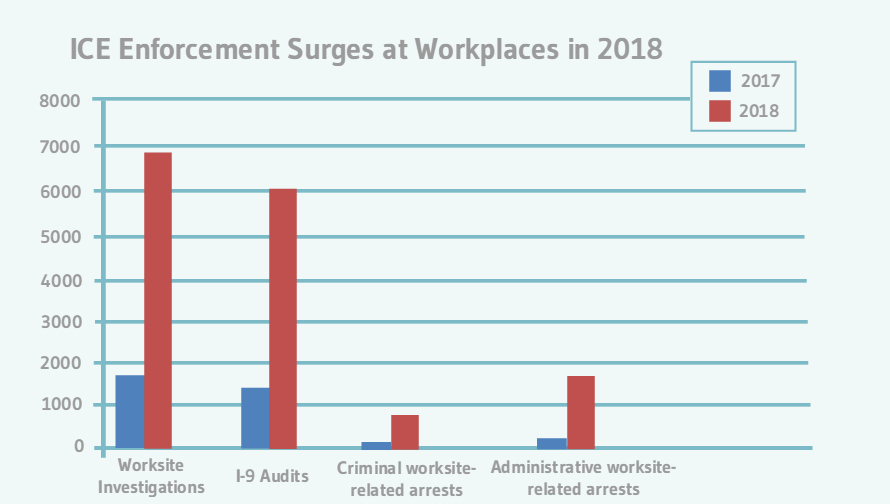Here is a wake-up call for employers thinking about shoring up their immigration compliance process as a New Year’s resolution. U.S. Immigration and Customs Enforcement (ICE) is targeting employers and has dramatically increased the number of worksite investigations, audits, and arrests.
How much has ICE increased its enforcement activity at U.S. employers’ worksites? Worksite investigations are up more than 300% from the fiscal year 2017. I-9 audits are up 340%. Criminal worksite related arrests are up 460%. And administrative worksite arrests are up 787% over 2017. These arrests can include not only undocumented workers but also the responsible hiring manager. Unlike most employment regulatory obligations, immigration compliance laws create the potential for personal, criminal liability for hiring managers and officials. Simply put, managers and company officials can go to jail for getting immigration compliance wrong. The following chart shows the dramatic increase in ICE activity during the last year:

What is the corporate exposure? Fines can be significant, even for “technical” violations where errors are made in completing the I-9 paperwork. Unfortunately, attention to this process is often seen as an afterthought, and personnel responsible for onboarding workers may receive little training. When mistakes are made, they are often replicated for a large group of employees and done for a period of years. To make matters worse, when ICE comes knocking, employers are only given 3 days to produce their records.
Fines vary depending on the percentage of employees involved, the severity of infractions, and whether the employer has had past issues. Generally, ICE follows the following schedules for assessing penalties. Note that these fines are per occurrence – simply multiply the fine level by the number of infractions that ICE finds during an audit. The percentage refers to the ratio of mistakes to number of employees. If an employer makes mistakes for just a small percentage of their workforce, then the fine is lower. If employers make mistakes across the board – a common problem for employers who do not properly train their staff – then the fines are much more substantial:
Knowing Hire / Continuing to Employ Fine Schedule
(Effective for penalties assessed after January 27, 2017 whose associated violations occurred after November 2, 2015)
Standard Fine Amount
Knowing Hire and Continuing to Employ Violations
First Tier
$548 – $4, 384Second Tier
$4,384 – $10,957Third Tier
$6,575 – $21,9160% – 9%
$548
$4,384
$6,575
10% – 19%
$1,140
$6,322
$8,547
20% – 29%
$1,754
$7,232
$11,177
30% – 39%
$2,411
$8,174
$13,807
40% – 49%
$3,069
$9,094
$16,568
50% or more
$3,726
$10,026
$19,242
Substantive / Uncorrected Technical Violation Fine Schedule
(Effective for penalties assessed after January 27, 2017 whose associated violations occurred after November 2, 2015)
Standard Fine Amount
Substantive Verification Violations
1st Offense
$220 – $2,1912nd Offense
$220 – $2,1913rd Offense +
$220 – $2,1910% – 9%
$220
$1,096
$2,191
10% – 19%
$548
$1,315
$2,191
20% – 29%
$876
$1,534
$2,191
30% – 39%
$1,205
$1,753
$2,191
40% – 49%
$1,534
$1,972
$2,191
50% or more
$1,862
$2,191
$2,191
The fine level can then go up or down, depending on various factors. ICE uses the following matrix to raise or lower the fine assessment:
Enhancement Matrix
Factor
Aggravating
Mitigating
Neutral
Business size
+ 5%
– 5%
+/- 0%
Good faith
+ 5%
– 5%
+/- 0%
Seriousness
+ 5%
– 5%
+/- 0%
Unauthorized Aliens
+ 5%
– 5%
+/- 0%
History
+ 5%
– 5%
+/- 0%
Cumulative Adjustment
+ 25%
– 25%
+/- 0%
This surge in enforcement seen across the country is staggering, but in retrospect, not surprising. In October 2017, ICE announced it would be significantly increasing its worksite enforcement efforts across the country. As part of that initiative, ICE was granted authority to hire 10,000 additional agents, while Customs and Border Patrol was given authority for hiring 5,000 more Border Patrol agents.
The contrast between the Obama and Trump administrations’ approaches toward immigration compliance is also striking. The Obama administration focused on targeting dangerous criminals, while the Trump administration is reverting back to an enforcement model that attacks the “employment magnet” by going after employers who use undocumented labor. The last few years of the Obama administration saw roughly 1250 worksite investigations per year, as compared to 6848 this year – nearly a 450% increase. Criminal arrests during the Obama era totaled approximately 239, compared to 713 this past fiscal year.
ICE sees this surge in enforcement as part of the overall strategy for securing the U.S. border. According to ICE’s Homeland Security Investigations Executive Associate Director Derek Benner, “reducing illegal employment helps build another layer of border security, and reduces the continuum of crime that illegal labor facilitates, from the human smuggling networks that facilitate illegal border crossings to the associated collateral crimes, like identity theft, document and benefit fraud and worker exploitation.”
We are finding that ICE agents are appearing increasingly zealous to fine employers, even employers who have no unauthorized workers but whose otherwise well-intentioned employees may have made paperwork mistakes in completing the I-9s. Moreover, as the result of much more aggressive enforcement against such fineable administrative oversights and errors—both ICE field agents and regional counsel appear to be taking what may be a practical or virtual zero-tolerance approach to such infractions, with expensive consequences for employers—even those with no past violations. The key for an employer is to have its ship in order on the front end, as many ICE agents do not appear to be in any position to show leniency. Now is the time for companies to perform a risk assessment, correct their onboarding processes, and update their I-9 records.